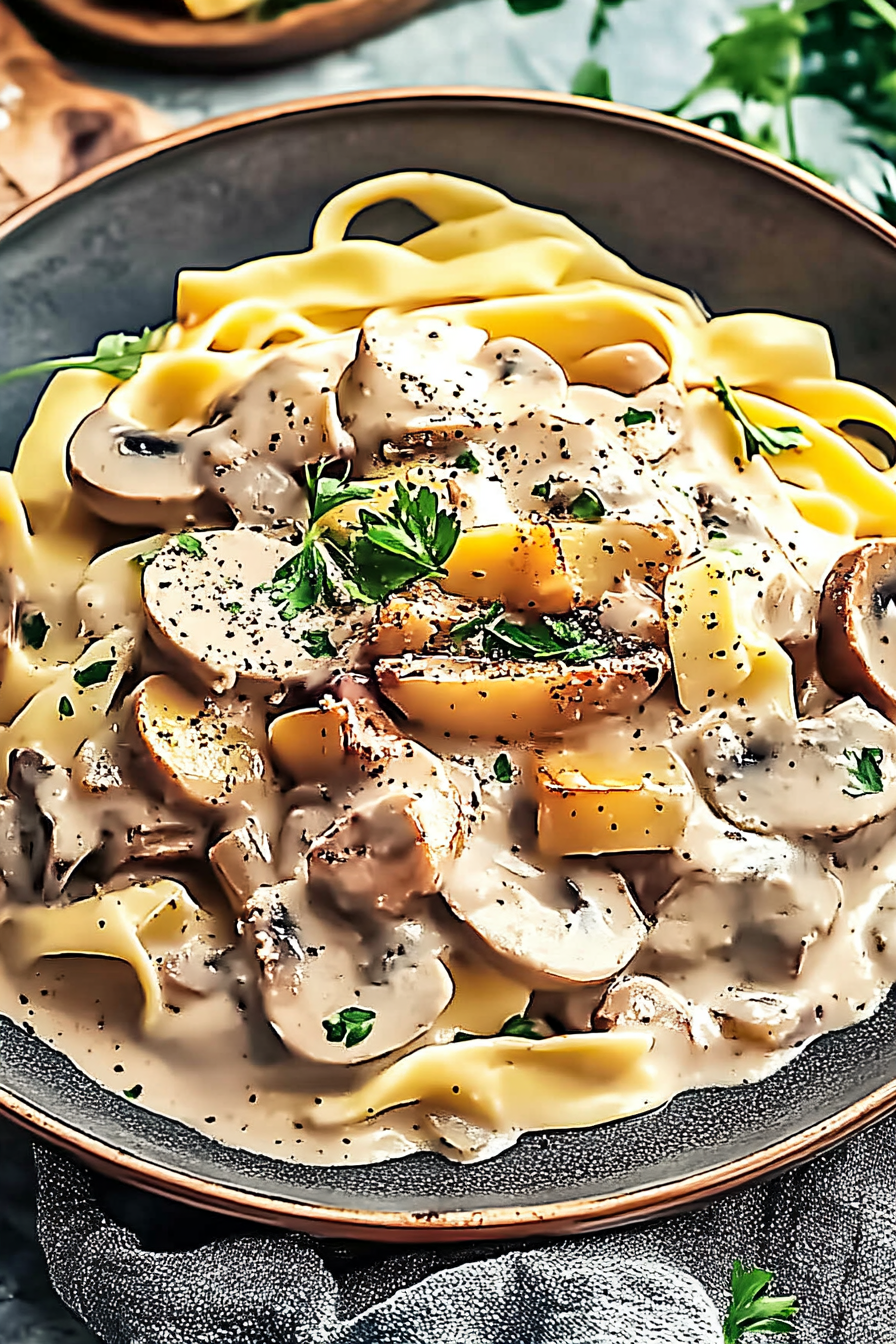Mastering vegan stroganoff
Vegan stroganoff is a comforting, creamy dish that rustles up the traditional flavors of beef stroganoff using mushrooms and plant-based ingredients. This recipe is simple yet satisfying, offering a rich sauce made creamy with full-fat coconut milk and tahini, perfectly balancing smoothness and umami. Ideal for vegans and those seeking a dairy-free or gluten-free meal, it pairs wonderfully with your choice of vegan pasta, creating a hearty meal that delivers on flavor without the heaviness of animal products.
Mastering this vegan stroganoff means understanding the role of various mushroom varieties, from cremini to shiitake, which provide texture and depth. The cooking technique—slowly browning mushrooms with leeks and garlic, then simmering them in a luscious, thickened sauce—brings out maximum flavor. It’s a flexible recipe that can be customized easily to include gluten-free or low-calorie ingredients, making it a versatile favorite for home cooks of all skill levels.
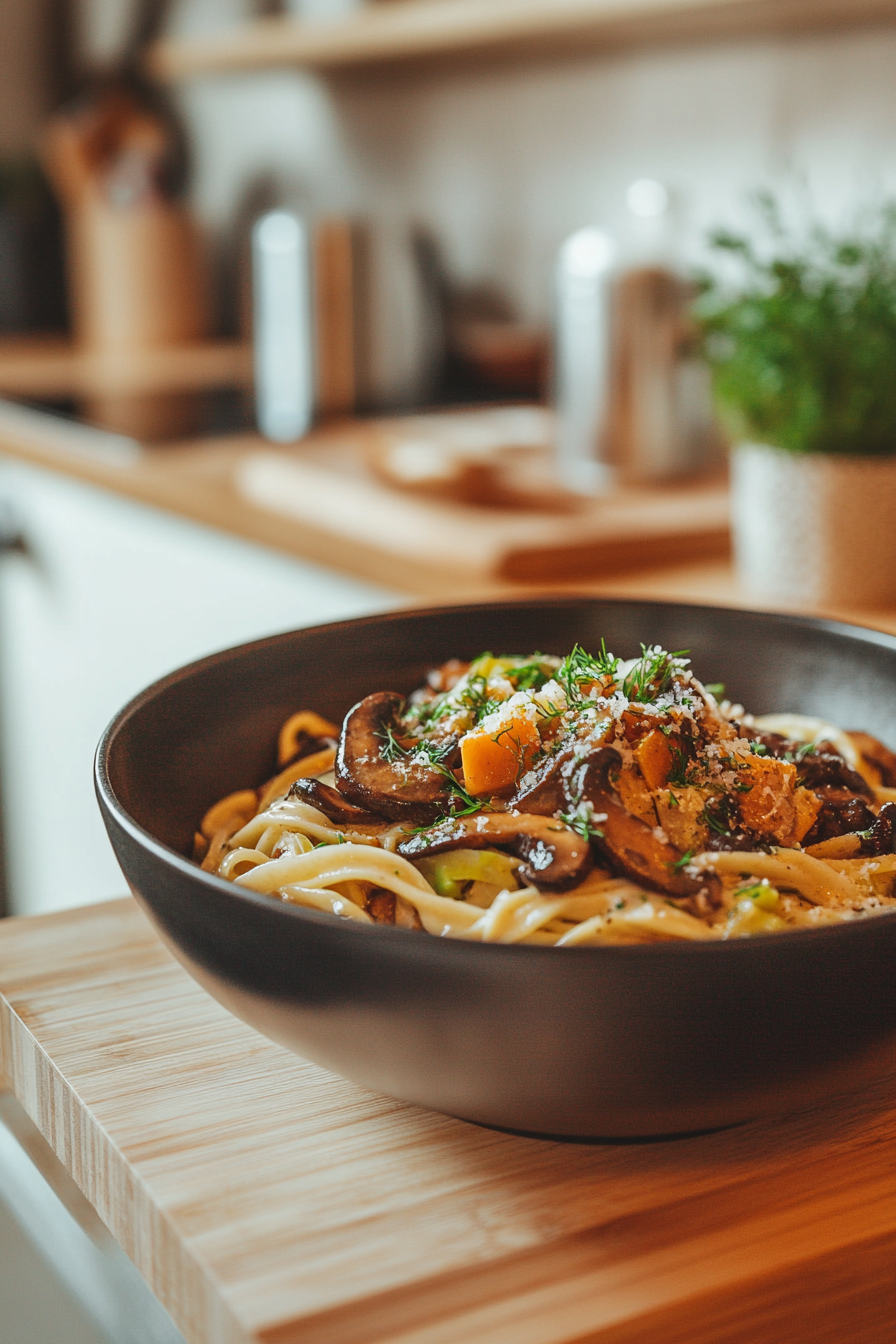
Benefits and Advantages of vegan stroganoff
This vegan stroganoff recipe stands out for its ease of preparation, health benefits, and the way it transforms plant ingredients into a rich, hearty entrée. Using a variety of mushrooms provides an excellent plant-based source of fiber, antioxidants, and vitamins, contributing to a diet rich in nutrients without excess saturated fat. The full-fat coconut milk and tahini ensure a creamy texture with healthy fats, while nutritional yeast adds a cheesy flavor and boosts B vitamins.
From a practical perspective, the recipe avoids common allergens by being free from dairy and gluten (when using gluten-free flour and pasta), making it suitable for many dietary requirements. Its straightforward steps allow busy cooks to prepare a tasteful meal without fuss, requiring only a few fresh, accessible ingredients. The versatility in pasta choice and optional ingredients like vegan butter or non-dairy milk make this a convenient dish to adapt with pantry staples, perfect for plant-based comfort food that satisfies.
Overall, this vegan stroganoff balances nutrition, flavor, and simplicity, making it a strong contender for anyone’s recipe repertoire looking for healthy, delicious vegan meals.
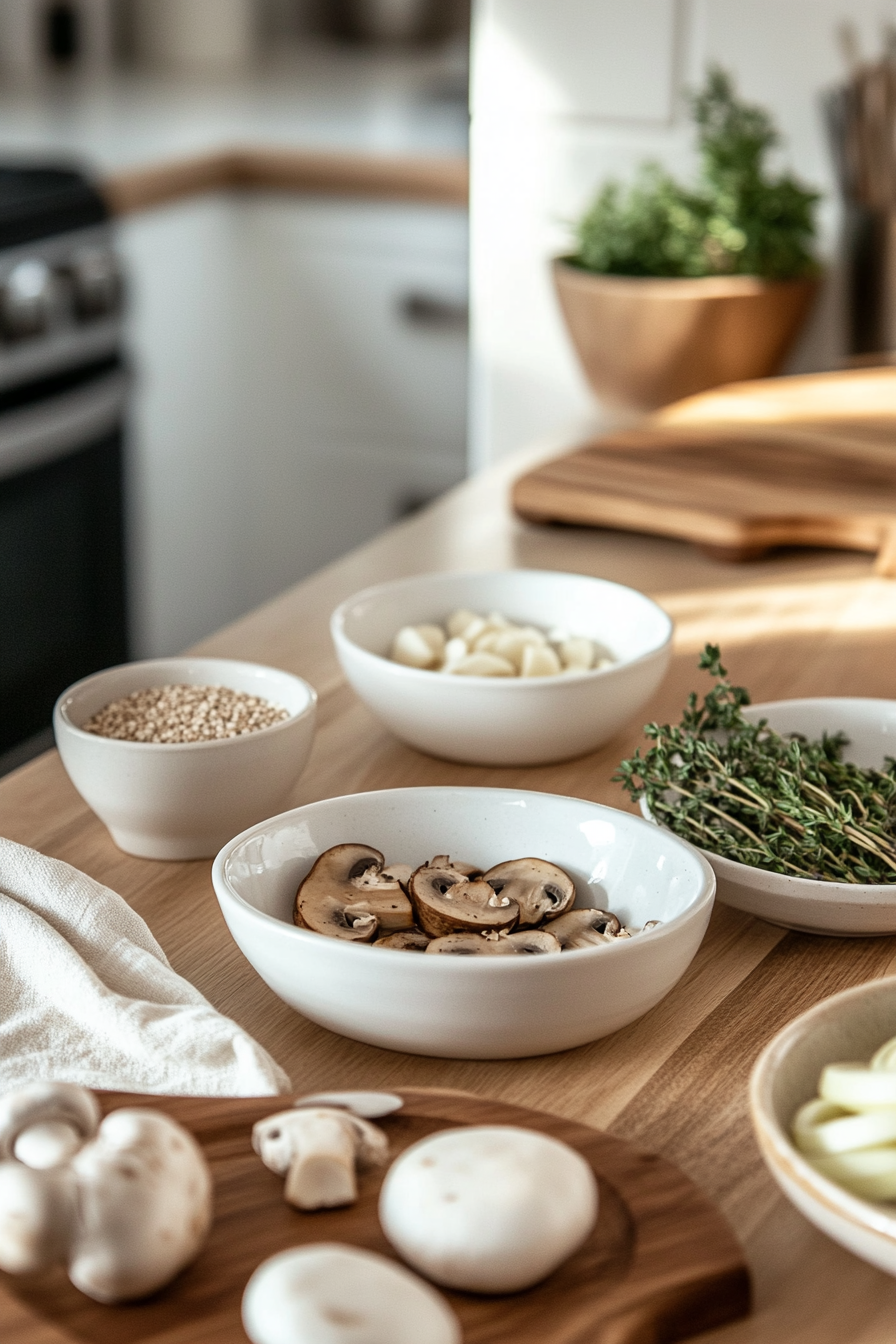
Essential Ingredients for vegan stroganoff
| Ingredient | Quantity | Purpose or Benefit |
|---|---|---|
| Olive oil | 3 to 4 tablespoons | For sautéing mushrooms and leeks, adds healthy fats |
| Leeks | 2 large or 3 small-medium | Provide a mild onion flavor |
| Mixed mushrooms (cremini, shiitake, oyster, maitake) | 20 ounces | Key source of umami and texture |
| Garlic | 6 cloves, minced | Enhances flavor complexity |
| Fresh thyme (or dried thyme) | 1 tablespoon fresh or 1 teaspoon dried | Adds earthy herbal notes |
| Kosher salt and black pepper | To taste | Seasoning to enhance all flavors |
| Vegetable broth | 1 ½ cups | Forms the savory base for the sauce |
| Tamari or soy sauce | 2 tablespoons | Provides umami depth and saltiness |
| Vegan Worcestershire sauce (optional) | 1 tablespoon | Adds tangy, smoky dimension |
| All-purpose flour (or gluten-free flour) | ¼ cup | Thickens the sauce |
| Dry white wine | ½ cup | Deglazes pan; adds bright acidity |
| Full-fat coconut milk | 1 can (13.5 oz) | Creates a creamy, rich texture |
| Tahini | 2 tablespoons | Enhances creamy mouthfeel and nutty flavor |
| Nutritional yeast | 2 tablespoons | Cheesy, savory flavor and B vitamins boost |
| Paprika | 1 teaspoon | Adds gentle smoky spice |
| Dijon mustard | ½ teaspoon | Brightens flavor and adds depth |
| Pasta of choice (vegan, gluten-free if preferred) | 12 ounces | Main starch component to serve |
| Fresh dill | ¼ cup, chopped | Optional garnish for freshness and aroma |
| Non-dairy milk (soy or almond, optional) | 1 cup | Variation for lighter creaminess instead of coconut milk |
| Vegan butter (optional) | 2 tablespoons | Alternative to olive oil for sautéing |
| Onion (yellow or shallots) | 1 cup, chopped | For added depth in the mushroom base |
Dietary Substitutions to Customize Your Vegan Stroganoff
This vegan stroganoff is flexible and can be easily customized based on dietary needs and ingredient availability. Below are suggestions to tailor the recipe:
- Fat Sources: Substitute olive oil with vegan butter for a richer flavor, or reduce oil quantity for lower fat content.
- Dairy Alternatives: Instead of full-fat coconut milk, use unsweetened soy or almond milk combined with vegan sour cream or cashew cream to adjust creaminess and flavor.
- Thickening Agents: Use gluten-free all-purpose flour or cornstarch as a thickener if gluten sensitivity is a concern. Arrowroot powder is another excellent gluten-free option.
- Umami Enhancers: If tamari or soy sauce contains gluten, use a certified gluten-free tamari for those with gluten intolerance. Nutritional yeast boosts savory flavors but can be omitted or replaced with miso paste for a different umami profile.
- Alcohol-Free Cooking: Replace white wine with additional vegetable broth or a splash of lemon juice and water mixture to maintain brightness without alcohol.
- Mushroom Varieties: Use favorite mushrooms available to you; shiitake and cremini add earthiness, while oyster and maitake provide texture variety.
- Pasta Choices: For gluten-free diets, opt for gluten-free noodles made from rice, corn, or legumes. For grain-free/specialty diets, spiralized vegetables like zucchini noodles can substitute traditional pasta.
Thoughtful substitutions ensure that vegan stroganoff fits a wide spectrum of lifestyles without compromising its rich, creamy appeal.
Learn more about the health benefits of mushrooms and why they’re a great addition to plant-based meals. For practical cooking tips, see how to cook vegan stroganoff, and discover creative uses of nutritional yeast in vegan cooking.
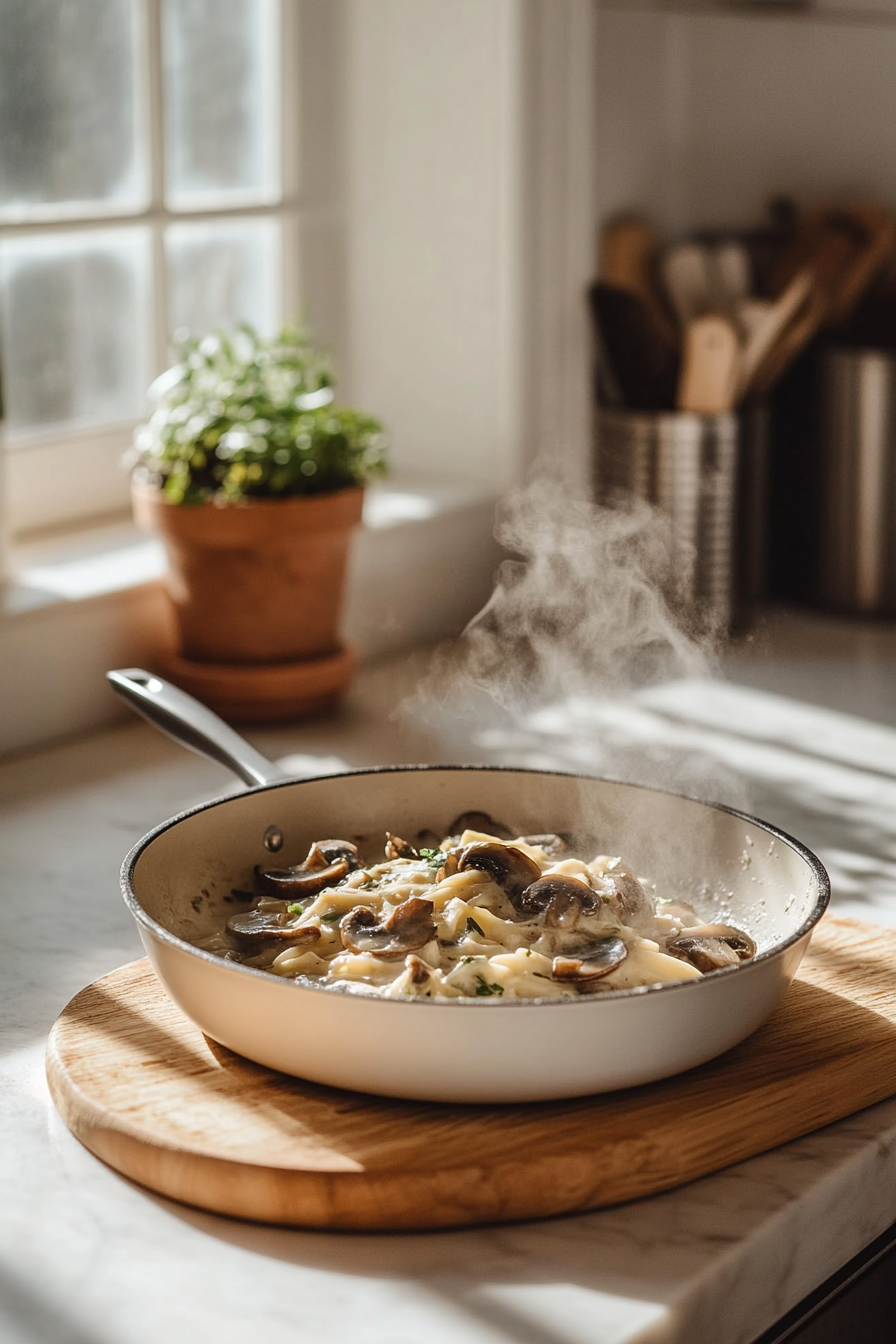
How to Prepare the Perfect Vegan Stroganoff: Step-by-Step Guide
- Clean and Prep Mushrooms and Leeks: Use a damp cloth or paper towel to clean 20 ounces of mixed mushrooms (e.g., cremini, shiitake, oyster, maitake). Tear or slice as needed. Trim, wash, and slice 2 large or 3 small-medium leeks thoroughly to remove grit.
- Sauté Vegetables: Heat 3 to 4 tablespoons olive oil (or 2 tablespoons vegan butter for a richer flavor) in a large pan over medium-high heat. Add mushrooms and leeks; cook for 8-10 minutes, stirring occasionally until mushrooms are nicely browned. Add 6 minced garlic cloves, 1 tablespoon fresh or 1 teaspoon dried thyme, kosher salt, and freshly cracked black pepper to taste. Continue cooking for 2-4 minutes until mushrooms become crispy. Cook mushrooms in batches if necessary to avoid overcrowding.
- Prepare the Roux and Sauce Base: In a separate bowl, whisk together 1 ½ cups vegetable broth, 1 cup non-dairy milk (soy or almond can be used instead of coconut milk), and ¼ cup all-purpose flour (gluten-free if preferred) until smooth. Add 2 tablespoons tamari or soy sauce, and 1 tablespoon vegan Worcestershire sauce (optional).
- Deglaze and Combine: Deglaze the mushroom pan with ½ cup dry white wine and let it simmer for about 3 minutes. Stir in the roux mixture, whisking to combine and remove lumps.
- Finish the Sauce: Gradually add 1 can (13.5 ounces) full-fat coconut milk, 2 tablespoons tahini, 2 tablespoons nutritional yeast, 1 teaspoon paprika, and salt to taste. Simmer gently for about 10 minutes, allowing the sauce to thicken.
- Cook Pasta and Combine: Meanwhile, cook 12 ounces pasta (vegan and gluten-free if preferred) according to package instructions. Drain and keep warm. Stir ½ teaspoon Dijon mustard into the sauce, toss the sauce with the pasta, and garnish with ¼ cup chopped fresh dill or parsley.
- Serve: Plate the pasta topped with the sautéed mushroom and leek mixture. Add extra fresh dill or parsley as garnish for added aroma and flavor.
Mastering Vegan Stroganoff: Advanced Tips and Variations
Elevate your vegan stroganoff by paying attention to the following tips and creative variations:
- Mushroom Variety and Quality: Combining different mushroom types gives a richer, layered flavor and improved texture. Cremini and shiitake provide meatiness, while oyster mushrooms add softness.
- Leek and Onion Combo: Swap or mix leeks with chopped yellow onion or shallots for added depth in aroma and taste.
- Adjust Sauce Thickness: Control the sauce consistency by modifying the amount of vegetable broth or cooking time. For a creamier texture, extend simmering; to thin the sauce, add a bit more broth.
- Non-Dairy Milk Options: For a different flavor profile, substitute full-fat coconut milk with soy or almond milk. Vegan sour cream can replace tahini for tanginess.
- Spice it Up: Add a pinch of smoked paprika or chili flakes for a subtle warming kick.
- Serving Suggestions: Serve over gluten-free noodles, rice, quinoa, or creamy mashed potatoes for varied textures and tastes.
Remember, slow cooking mushrooms without overcrowding is key for caramelized flavor and perfect texture.
How to Store Vegan Stroganoff: Best Practices
Proper storage maximizes flavor and freshness for vegan stroganoff leftovers:
Refrigeration
- Store cooled stroganoff in an airtight container in the refrigerator for 3 to 5 days.
- Keep the sauce and mushroom mixture combined to retain moisture and flavor.
Freezing
- Freezing is not recommended as mushrooms can lose texture and become mealy.
- If necessary, freeze only the sauce in airtight containers for up to 2 months, thawing and reheating gently to restore creaminess.
Reheating
- Warm leftovers on the stovetop over low heat, stirring frequently to prevent sticking and promote even heat distribution.
- Avoid microwaving if possible, or use lower power settings and stir halfway through reheating.
Nutritional Value of Vegan Stroganoff
| Nutrient | Approximate Amount per Serving |
|---|---|
| Calories | 525 kcal |
| Carbohydrates | 60 g |
| Protein | 16 g |
| Fat | 25 g |
| Saturated Fat | 14 g |
| Sodium | 560 mg |
| Potassium | 748 mg |
| Fiber | 5 g |
| Sugar | 5 g |
This vegan stroganoff is a hearty, nutrient-rich meal, providing a good balance of macronutrients along with a generous dose of fiber and potassium. Mushrooms contribute to the protein content while being low in calories and fat. For more insights, see the health benefits of mushrooms.
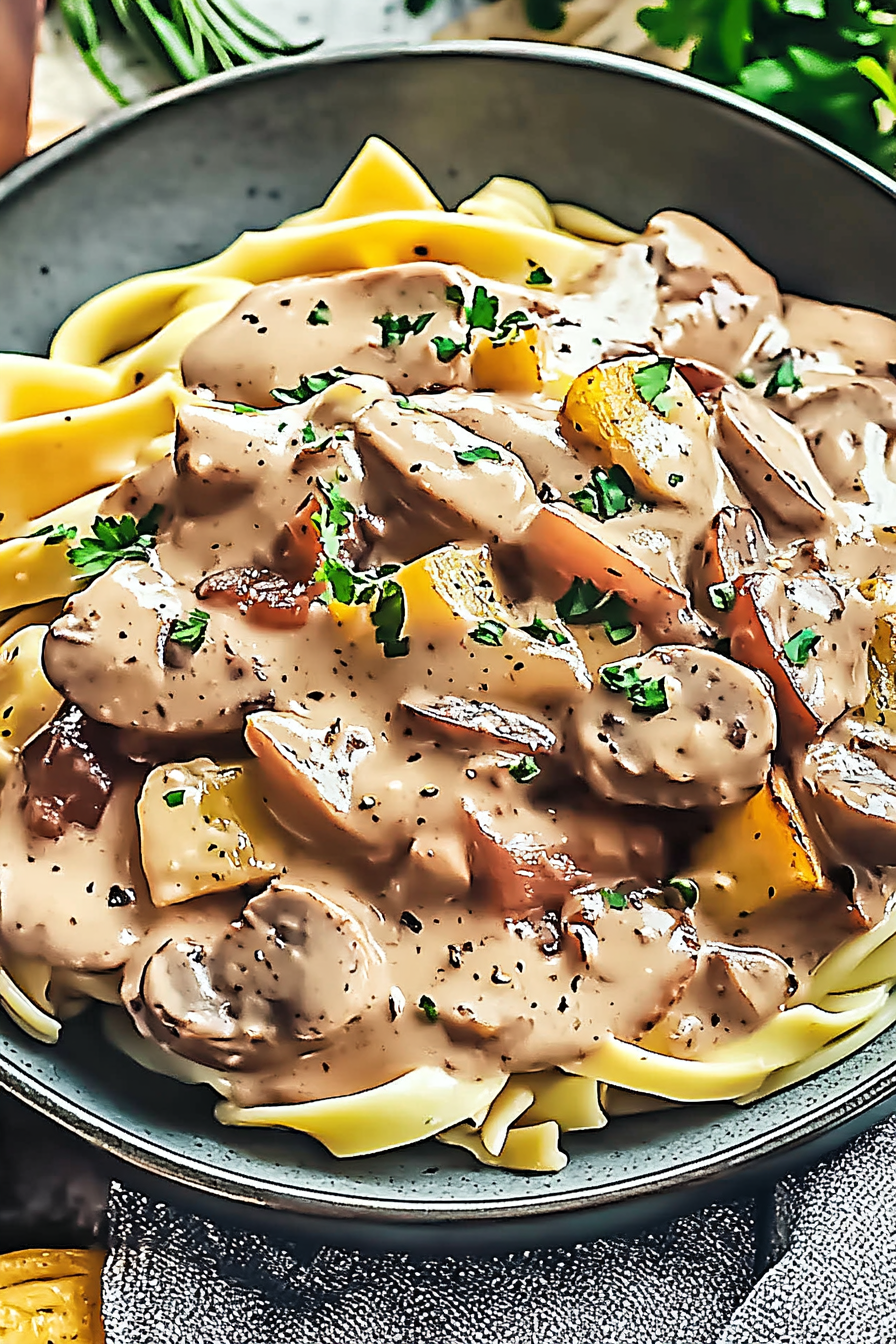
FAQs: Frequently Asked Questions About Vegan Stroganoff
What can you serve vegan stroganoff with?
Vegan stroganoff pairs well with various options such as gluten-free pasta, rice, quinoa, or mashed potatoes. Each choice offers its own texture and flavor, enabling you to customize the meal to your preference.
What is a good substitute for white wine in vegan stroganoff?
Vegetable broth is a great alcohol-free alternative to white wine. You can also mix equal parts white vinegar and water for acidity, but use sparingly to avoid overpowering flavors.
Can you use a different milk alternative instead of full-fat coconut milk?
Yes, vegan sour cream is a suitable substitute offering creaminess with tang. However, thinner vegan milks like almond or soy may thin the sauce excessively and reduce richness.
How do you prevent common mistakes when cooking mushrooms for vegan stroganoff?
Clean mushrooms gently with a damp cloth to avoid sogginess, avoid overcrowding the pan to allow evaporation and browning, and cook over medium-high heat for better caramelization. These steps ensure flavorful, tender mushrooms.

Rich and Creamy Vegan Stroganoff with Mushrooms: Easy Plant-Based Recipe
- Total Time: 1 hour 10 minutes
- Yield: 4 servings 1x
- Diet: Vegan
Description
🍄 This Rich and Creamy Vegan Stroganoff is packed with flavor and texture, making it a delightful plant-based alternative to traditional stroganoff.
🌱 Easy to customize and perfect for both weeknight dinners and impressing guests with a comforting, hearty meal.
Ingredients
Olive oil: 3 to 4 tablespoons
Leeks: 2 large or 3 small-medium
Mixed mushrooms: 20 ounces (such as cremini, shiitake, oyster, maitake)
Garlic: 6 cloves, minced
Fresh thyme: 1 tablespoon or 1 teaspoon dried thyme
Kosher salt and freshly cracked black pepper to taste
Vegetable broth: 1 1/2 cups
Tamari or soy sauce: 2 tablespoons
Vegan Worcestershire sauce: 1 tablespoon (optional)
All-purpose flour: 1/4 cup (use gluten-free if preferred)
Dry white wine: 1/2 cup
Full-fat coconut milk: 1 can (13.5 ounces)
Tahini: 2 tablespoons
Nutritional yeast: 2 tablespoons
Paprika: 1 teaspoon
Dijon mustard: 1/2 teaspoon
Pasta of choice: 12 ounces (vegan, gluten-free if preferred)
Fresh dill: 1/4 cup, chopped
1 cup non-dairy milk (such as soy or almond instead of coconut milk for variation)
Vegan butter: 2 tablespoons (optional, instead of olive oil)
Onion (yellow or shallots): 1 cup, chopped
Instructions
1. Clean mushrooms with a cloth or paper towel to prevent sogginess and slice or tear as needed. Trim, wash, and slice leeks thoroughly.
2. Heat a pan over medium-high heat, add olive oil (or vegan butter), mushrooms, and leeks; cook for 8-10 minutes, stirring occasionally until mushrooms are brown. Add minced garlic, thyme, and salt; continue to cook for 2-4 minutes until mushrooms are crispy. Cook mushrooms in batches if necessary to avoid overcrowding.
3. In a separate bowl, whisk together vegetable broth, non-dairy milk, and flour to create a smooth mixture (roux). Add tamari, Worcestershire sauce (if using).
4. Deglaze the pan with dry white wine and allow it to simmer for 3 minutes. Stir in the roux.
5. Gradually add coconut milk, tahini, nutritional yeast, salt, paprika; simmer for about 10 minutes until sauce thickens.
6. Meanwhile, cook pasta according to the package instructions, then drain and keep it warm.
7. Incorporate Dijon mustard into the sauce, toss with the pasta and garnish with fresh dill or parsley.
8. Serve by plating the pasta topped with the sautéed mushrooms and leek mixture, adding extra dill or parsley as garnish.
Notes
🍄 Combine different mushroom varieties for rich flavor and texture.
🧅 Opt for leeks over onions for a milder taste, or include both for depth.
🌿 Garnishing with fresh parsley or dill enhances aroma and flavor.
- Prep Time: 20 minutes
- Cook Time: 50 minutes
- Category: Main Course
- Method: Sautéing
- Cuisine: Vegan
Nutrition
- Serving Size: 1/4 of recipe
- Calories: 525
- Sugar: 5g
- Sodium: 560mg
- Fat: 25g
- Saturated Fat: 14g
- Unsaturated Fat: 11g
- Trans Fat: 0g
- Carbohydrates: 60g
- Fiber: 5g
- Protein: 16g
- Cholesterol: 0mg

